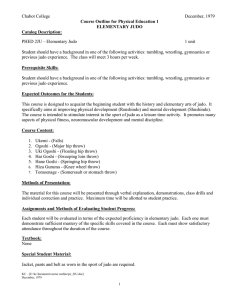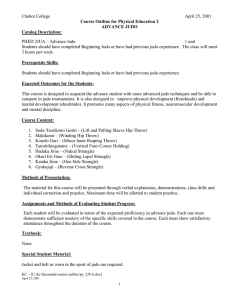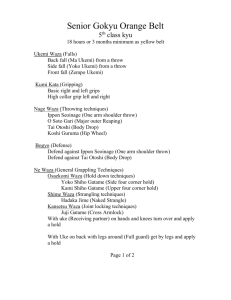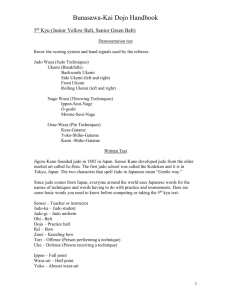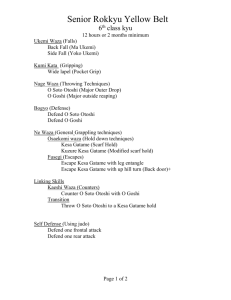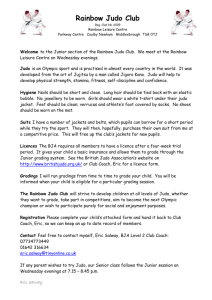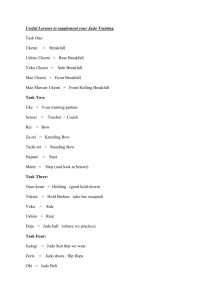File - Illini Judo Club
advertisement
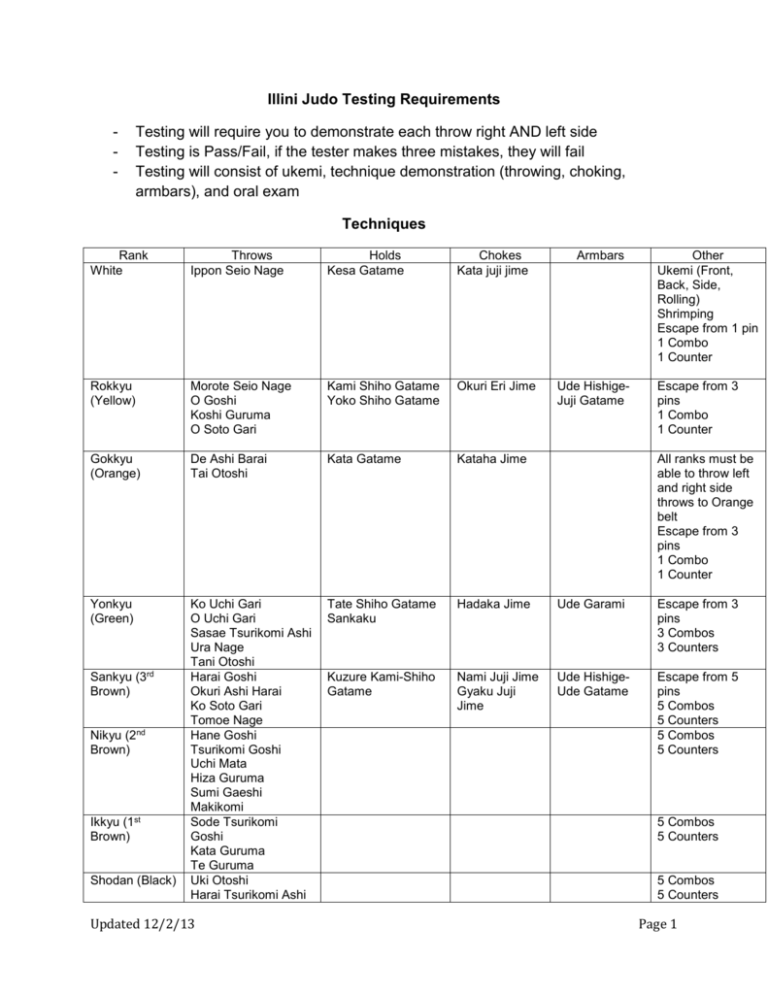
Illini Judo Testing Requirements - Testing will require you to demonstrate each throw right AND left side Testing is Pass/Fail, if the tester makes three mistakes, they will fail Testing will consist of ukemi, technique demonstration (throwing, choking, armbars), and oral exam Techniques Rank White Throws Ippon Seio Nage Holds Kesa Gatame Chokes Kata juji jime Rokkyu (Yellow) Morote Seio Nage O Goshi Koshi Guruma O Soto Gari Kami Shiho Gatame Yoko Shiho Gatame Okuri Eri Jime Gokkyu (Orange) De Ashi Barai Tai Otoshi Kata Gatame Kataha Jime Yonkyu (Green) Ko Uchi Gari O Uchi Gari Sasae Tsurikomi Ashi Ura Nage Tani Otoshi Harai Goshi Okuri Ashi Harai Ko Soto Gari Tomoe Nage Hane Goshi Tsurikomi Goshi Uchi Mata Hiza Guruma Sumi Gaeshi Makikomi Sode Tsurikomi Goshi Kata Guruma Te Guruma Uki Otoshi Harai Tsurikomi Ashi Tate Shiho Gatame Sankaku Hadaka Jime Ude Garami Escape from 3 pins 3 Combos 3 Counters Kuzure Kami-Shiho Gatame Nami Juji Jime Gyaku Juji Jime Ude HishigeUde Gatame Escape from 5 pins 5 Combos 5 Counters 5 Combos 5 Counters Sankyu (3rd Brown) Nikyu (2nd Brown) Ikkyu (1st Brown) Shodan (Black) Updated 12/2/13 Armbars Ude HishigeJuji Gatame Other Ukemi (Front, Back, Side, Rolling) Shrimping Escape from 1 pin 1 Combo 1 Counter Escape from 3 pins 1 Combo 1 Counter All ranks must be able to throw left and right side throws to Orange belt Escape from 3 pins 1 Combo 1 Counter 5 Combos 5 Counters 5 Combos 5 Counters Page 1 Judo (柔道 jūdō?, meaning "gentle way") is a modern martial art and combat sport created in Japan in 1882 by Jigoro Kano. Its most prominent feature is its competitive element, where the object is to either throw or takedown one's opponent to the ground, immobilize or otherwise subdue one's opponent with a grappling maneuver, or force an opponent to submit by joint locking or by executing a strangle hold or choke. Strikes and thrusts by hands and feet as well as weapons defenses are a part of judo, but only in pre-arranged forms (kata) and are not allowed in judo competition or free practice (randori). The philosophy and subsequent pedagogy developed for judo became the model for other modern Japanese martial arts that developed from koryū (古流?, traditional schools). The worldwide spread of judo has led to the development of a number of offshoots such as Sambo and Brazilian Jiu-Jitsu. Practitioners of judo are called judoka. Principle of Judo Ju the principle of gentleness, yielding, or giving way Do way, path, or principle Judo the gentle way SeiryokuZen'yo maximum efficiency mutual benefit and welfare Jita Kyoei General Vocabulary Sensei teacher or instructor Dojo place or club where Judo is practiced Gi (Judogi) Judo uniform Seiza kneeling position Anza sitting position with legs crossed Ritsurei standing bow Zarei kneeling bow Kiotsuke! (come to) attention! Updated 12/2/13 Page 2 Rei! bow! Sensei Ni Rei! bow! (to Sensei) Ukemi falling practice (side, back, forward) Uchi Komi repetition practice without throwing Randori free practice Kiai shout during execution of technique Japanese Numbers Ichi 1 Ni 2 San 3 Shi 4 Go 5 Roku 6 Shichi 7 Hachi 8 Ku 9 Ju l0 Practice Tori The person who executes a technique Uke The person on whom a technique is being used Ukemi Breakfalls Kuzushi Breaking Balance Updated 12/2/13 Page 3 Uchikomi Practice Throws Tachi Waza Standing Techniques Ne Waza Ground Work Ashi Waza Foot Techniques Kumi Kata Gripping Techniques Nage Komi Full execution throws Competition Hajime Begin Mate Stop Osaekomi Holding Toketa Hold Broken Sore Made Match Over Points Ippon One Full Point Waza-ari Half-point Yuko Partial Point or Advantage Penalties Hansoku Make Final Penalty Shido Small Penalty Updated 12/2/13 Page 4 During the fight there will be three Shidos, and the fourth Hansoku-make (3 warnings and then disqualification). Shidos do not give points to the other fighter, only technical scores can give points on the scoreboard. At the end of the fight, if scoring is equal, the one with less Shido wins. If the fight continues to golden score (due to a draw), the first receiving a Shido loses, or the first scoring a technique will win. Penalized with Shido -Breaking the grip with 2 hands. -Cross gripping should be followed by an immediate attack. Same rule as for the belt gripping and one side gripping. The referees should strictly penalize the contestants who do not engage in a quick Kumikata grip or who try not to be gripped by the opponent. -To hug the opponent for a throw. (Bear hug). Penalized with Hansoku-make: All attacks or blocking with one or two hands or with one or two arms below the belt in Tachi-waza. The bow When entering the tatami area, fighters should walk to the entrance of the contest area at the same time and bow to each other into the contest area. The contestants must not shake hands BEFORE the start of the contest. Sample questions for Oral Exam - What set Judo apart from traditional Japanese JuJitsu? What dojo is considered the historical center of Judo? Name three different ways to earn a “Shido” Name three ways to earn a “Hansoku Make” and be removed from competition for the tournament Name one way to earn a “Hansoku Make” and be removed from competition for the match Describe “Kuzushi” Other questions maybe asked Updated 12/2/13 Page 5 There are four factors common in every throwing technique. If you understand these four factors, you understand why and how throwing techniques work. They are: 1. Kuzushi: or controlling an opponent’s balance, movement and body position. 2. Tsukri: which is the movement where the attacker fits his body into position to throw his opponent. 3. Kake: the actual execution of the throw. 4. Kime: the follow through or finish to the throw. KUZUSHI: Controlling (Breaking) Balance Movement is the most important part of kuzushi. The word “kuzushi” translates to the action of breaking down the body. It’s controlling an opponent’s body and the most effective way of doing that is to do it when he is moving. Controlling and breaking your opponent’s balance is a combination of a lot of things that happen in a sequence (but in a fast and controlled sequence) of events—and movement is the most important element. When you “break” your opponent’s balance, it’s because you’ve controlled the grip or tie-up, the space between your body and your opponent’s body, the movement of both your body and his body, the speed of how fast your bodies move about the mat as well as the direction you want to go and the momentum into the direction of the attack. Sometimes, it can be a subtle movement on your part but just as often the throwing attack is a result of an explosive and continuous body movement on your part resulting in a throw. TSUKURI: Preparing to Throw or Fitting Into Position This is the phase during the throwing action when the thrower actually applies the throwing movement and constructs the throw. “Tsuku” means to prepare or build something and “ri” implies doing it to a person. The concept of Tsukuri implies “preparing a person” to be thrown. Often, judo people translate it to mean “fitting in” and this is a good translation as well. What this all means is that the thrower moves his body into position to prepare his opponent to be thrown. Kuzushi and Tsukuri blend together into a Kuzushi/Tsukuri movement rather than two separate movements. Tsukuri is dependant upon Kuzushi to be effective. KAKE: Execution of the Throw This phase of the throwing attack is the actual execution of the throw. Kake translates to a phrase that implies “joining together.” In other words, the attacker’s body and the defender’s body are joined or connected together at the point of the attacker’s throwing action with the attacker in control of how the bodies get to the ground or mat KIME: Follow Through or Effectively Finishing the Throw This is the “follow through” that enables the thrower to determine how hard (or soft) his opponent lands on the mat as well as where the defender lands (primarily on the back). “Kime” translates to imply the focus, follow-through or effective finish to the technique. The momentum of the attacker’s body and the defender’s body creates a “follow through” in the exact same way a golfer follows through in his swing after he hits the ball with his club. If the attacker tried to stop the action at the point of Kake, he would lose control of his opponent’s body and the effectiveness of the throw would be lost, or Updated 12/2/13 Page 6 certainly diminished. For a throw to be effective, Kake blends directly into Kime with no stop in the action. Formal Bow in/Bow out steps Beginning of class 1.) Class lines up by rank infront of Senseis 2.) The highest ranked will say "Kiotsuke!" which means (come to) attention! 3.) Say "Rei!" - which means bow - this is a sign of respect 4.) Then the whole class bows 5.) Senseis may address the class and then practice will begin End of class 1.) Class lines up by rank infront of Senseis 2.) The highest ranked will say "Kiotsuke!" which means (come to) attention! 3.) Next say "Seiza" which everyone will kneel 4.) Next say "Mokuso" which means to meditate after practice 5.) Give some time for the class to meditate, when you feel that it’s enough say "Mokuso Yame" which finishes meditation 6.) Next say "Sensei Ni Rei!", class bows, then "Dojo Ni Rei", class bows, then the Sensei will say "Class Ni Rei." The pursuit of judo will also build the practitioner's character. Some will call this a moral education. From the hundreds of, thousands of hours of mat time, whatever hard edges you have tend to get worn down, and softened. Given enough time, aggressors become victims, victims aggressors, students become teachers, and teachers remain students. By doing judo, you will learn how to get up when defeated, take victory with humility, have empathy for the weak, have respect for the strong, learn to use other's force against themselves, to use your force efficiently, and for good purpose. These 'lessons' are learned from returning to that mat night after night, day after day, year after year, and are what forms the foundation of the 'character building' education of judo. Updated 12/2/13 Page 7
